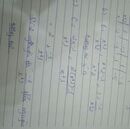Hãy nhập câu hỏi của bạn vào đây, nếu là tài khoản VIP, bạn sẽ được ưu tiên trả lời.

Trả lời:
a, \(A=\frac{x+5}{x+2}=\frac{x+2+3}{x+2}=\frac{x+2}{x+2}+\frac{3}{x+2}=1+\frac{3}{x+2}\)
Để \(A\inℤ\) thì \(\frac{3}{x+2}\inℤ\)
\(\Rightarrow3⋮x+2\Rightarrow x+2\inƯ\left(3\right)=\left\{\pm1;\pm3\right\}\)
Ta có bảng sau:
| x+2 | 1 | -1 | 3 | -3 |
| x | -1 | -3 | 1 | -5 |
Vậy \(x\in\left\{-1;-3;1;-5\right\}\)
b, \(B=\frac{x+1}{x+2}=\frac{x+2-1}{x+2}=\frac{x+2}{x+2}-\frac{1}{x+2}=1-\frac{1}{x+2}\)
Để A là số nguyên thì \(1⋮x+2\Rightarrow x+2\inƯ\left(1\right)=\left\{\pm1\right\}\)
Ta có bảng sau:
| x+2 | 1 | -1 |
| x | -1 | -3 |
Vậy \(x\in\left\{-1;-3\right\}\)
c, \(C=\frac{2x-1}{x+1}=\frac{2\left(x+1\right)-3}{x+1}=\frac{2\left(x+1\right)}{x+1}-\frac{3}{x+1}=2-\frac{3}{x+1}\)
Để C là số nguyên thì \(3⋮x+1\Rightarrow x+1\inƯ\left(3\right)=\left\{\pm1;\pm3\right\}\)
| x+1 | 1 | -1 | 3 | -3 |
| x | 0 | -2 | 2 | -4 |
Vậy \(x\in\left\{0;-2;2;-4\right\}\)

a: \(B=\left(\dfrac{x}{\left(x-2\right)\left(x+2\right)}-\dfrac{2}{x-2}+\dfrac{1}{x+2}\right):\left(x-2+\dfrac{10-x^2}{x+2}\right)\)
\(=\dfrac{x-2x-4+x-2}{\left(x-2\right)\left(x+2\right)}:\dfrac{x^2-4+10-x^2}{x+2}\)
\(=\dfrac{-6}{\left(x-2\right)\left(x+2\right)}\cdot\dfrac{x+2}{6}=\dfrac{-1}{x-2}\)
b: Khi x=1/2 thì \(B=\dfrac{-1}{\dfrac{1}{2}-2}=\dfrac{2}{3}\)
Khi x=-1/2 thì B=2/5
c: Để B nguyên thì \(x-2\in\left\{1;-1\right\}\)
hay \(x\in\left\{3;1\right\}\)
a, đk : x khác -2 ; 2
\(B=\left(\dfrac{x-2\left(x+2\right)+x-2}{\left(x-2\right)\left(x+2\right)}\right):\left(\dfrac{x^2-4+10-x^2}{x+2}\right)\)
\(=\dfrac{-6}{\left(x-2\right)\left(x+2\right)}:\dfrac{6}{x+2}=\dfrac{1}{2-x}\)
b, Ta có \(\left|x\right|=\dfrac{1}{2}\Leftrightarrow x=\dfrac{1}{2};x=-\dfrac{1}{2}\)
Với x = 1/2 ta được \(B=\dfrac{1}{2-\dfrac{1}{2}}=\dfrac{2}{3}\)
Với x = -1/2 ta được \(B=\dfrac{1}{2+\dfrac{1}{2}}=\dfrac{2}{5}\)
c, \(\dfrac{1}{2-x}\Rightarrow2-x\inƯ\left(1\right)=\left\{\pm1\right\}\)
| 2-x | 1 | -1 |
| x | 1 | 3 |

a)
ĐKXĐ: \(x\ne-4\)
Để A nguyên thì \(3x+21⋮x+4\)
\(\Leftrightarrow3x+12+9⋮x+4\)
mà \(3x+12⋮x+4\)
nên \(9⋮x+4\)
\(\Leftrightarrow x+4\inƯ\left(9\right)\)
\(\Leftrightarrow x+4\in\left\{1;-1;3;-3;9;-9\right\}\)
\(\Leftrightarrow x\in\left\{-3;-5;-1;-7;5;-13\right\}\)(nhận)
Vậy: Để A nguyên thì \(x\in\left\{-3;-5;-1;-7;5;-13\right\}\)
b) ĐKXĐ: \(x\ne\dfrac{1}{2}\)
Để B nguyên thì \(2x^3-7x^2+7x+5⋮2x-1\)
\(\Leftrightarrow2x^3-x^2-6x^2+3x+4x-2+7⋮2x-1\)
\(\Leftrightarrow x^2\left(2x-1\right)-3x\left(2x-1\right)+2\left(2x-1\right)+7⋮2x-1\)
\(\Leftrightarrow\left(2x-1\right)\left(x^2-3x+2\right)+7⋮2x-1\)
mà \(\left(2x-1\right)\left(x^2-3x+2\right)⋮2x-1\)
nên \(7⋮2x-1\)
\(\Leftrightarrow2x-1\inƯ\left(7\right)\)
\(\Leftrightarrow2x-1\in\left\{1;-1;7;-7\right\}\)
\(\Leftrightarrow2x\in\left\{2;0;8;-6\right\}\)
hay \(x\in\left\{1;0;4;-3\right\}\)(nhận)
Vậy: \(x\in\left\{1;0;4;-3\right\}\)

a: ĐKXĐ: x<>1; x<>-1
b: \(A=\dfrac{\left(x-1\right)^2}{\left(x-1\right)\left(x+1\right)}=\dfrac{x-1}{x+1}\)
c: Để A nguyên thì x+1-2 chia hết cho x+1
=>\(x+1\in\left\{1;-1;2;-2\right\}\)
=>\(x\in\left\{0;-2;-3\right\}\)
